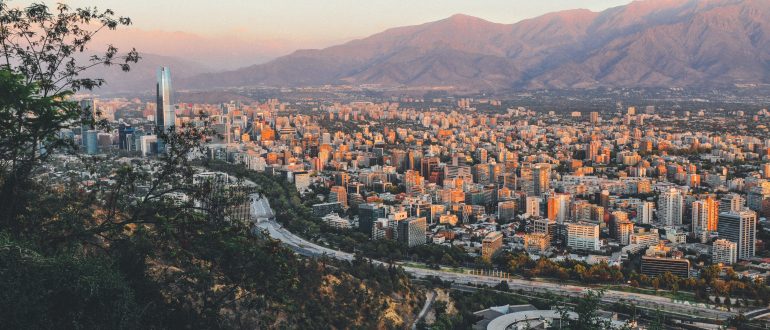
The Role of Cities in Climate Change-Induced Migration: Shared Lessons from Latin America and Europe

For the spanish version click here.
Climate change-induced migration
Climate change-induced migration is increasingly incorporated into international debates, but there is a lack of emphasis on the connections between climate change and shifting migration patterns. This connection is highly complex and uncertain, with predictions of ‘climate refugees’ ranging from 25 to 300 million by 2050. Given that migration is increasingly towards cities, there is a crucial need to understand the dynamics between environmental change, human mobility and urbanization.
The relevance of this connection poses great challenges for the creation of adequate policy responses across the globe, which heavily rely on city-level planning. It is thus vital to explore the centrality and potential of cities in managing climate-change induced migration through a comparison of relevant cases in Latin America and Europe. Latin American countries are increasingly experiencing national and transnational migration towards urban areas. Yet, climate change-induced migration is not merely an issue of the ‘Global South’ and is already a lived reality across the globe, including Europe. This became particularly clear in the wake of the European ‘refugee crisis’. The arrival of Middle Eastern and African refugees and migrants can partly be attributed to climate related events such as severe draughts across the Middle East and large parts of Africa. Since both European and Latin American migration trends are predominantly towards urban hubs and peripheries, it is imperative to examine the potential of cities and their infrastructures in managing migration processes in both regions.
Latin America and Urban Resilience
The world is rapidly urbanizing, with 50% of the global population and two thirds of the current 22.5 million refugees (2018 numbers) living in urban areas.[i] Climate migrants increasingly move to cities to look for better opportunities. In the context of Latin America, these are predominantly farmers on the verge of loosing their sources of livelihoods due to extreme weather events. When climate migrants have enough resources to be able to move, they tend to look for opportunities in the nearest cities. Patterns show that migrants will move within their own country if the available urban areas have adequate infrastructures and opportunities. Otherwise, rural-to-urban migration is likely to become a transnational phenomenon towards cities in other countries with better prospects. Migration bears undeniable potential, as it can boost economic growth due to spillovers and agglomeration.[ii] Therefore, a city capable of hosting climate migrants can enjoy a positive economic impact by leveraging the socio-economic and cultural capital of migrants.
On the other hand, urban concentration can also worsen problems like pollution, congestion and the emergence of large slums with a drastic lack of access to basic social needs. This is mostly relevant in the context of developing countries. If there is a low rate of urbanization, the inflow of migrants will likely be a backlash to the city and thus it becomes harder to strengthen urban resilience.[iii] This shows that there are both opportunities and challenges connected to migration-driven urbanization, which thus requires thorough management and adequate policy responses.
As a region, Latin America and the Caribbean is vulnerable to the impacts of climate change. In 2015, there was a total of 1.5 million displaced people due to weather and natural events.[iv] The most vulnerable countries are Bolivia, Haiti, Guyana, Honduras, and Guatemala. Over the last years there has been an increasing shock to Bolivia’s most vulnerable population, whom are predominantly indigenous peoples. Due to increasing temperatures and El Niño related droughts, the Poopó lake is almost dry. Yet, this lake largely supports the livelihood base for the large indigenous group called the Urus. As a consequence, many Urus have migrated to cities to work in the informal sector, or even to Chile and Argentina to work in factories in urban peripheries. Simultaneously, Haiti has suffered much from extreme weather effects and a destructive earthquake. In conjunction with the existing socio-economic conditions, these events have led to the transnational migration of an astounding 15 percent of the total Haitian population.[v]
Climate migrants like Urus and Haitians working in the informal sector usually end up living in large slums and informal settlements. Yet, these migrants can increase the economic prospects of a city if the process of urbanization is managed. This shows that urban planning will play an important role in determining the challenges and potential in migration-driven urbanization throughout Latin America and the Caribbean.
Europe and Transnational Migration to Cities
In today’s constantly shrinking world, the local impacts of climate change in certain regions also impact other regions. This can clearly be detected in the way that climate change has accelerated Middle Eastern and African migration towards Europe. Between 2006 and 2011, large parts of rural Syria suffered severe draughts as a consequence of climate change, which directly led to the loss of livelihoods for thousands and a massive increase in rural-to-urban migration. This is widely regarded to have worsened the already existing social unrest and political turmoil, which eventually led to Syria’s civil war, massive displacement and migration towards other Middle Eastern and European countries.
Similarly, across Northern and Sub-Saharan Africa, climate change events such as draughts, desertification, floods and a lack of water are massively impacting human mobility. The increase of African and Middle Eastern migration towards Europe is thus a consequence of a variety of push-factors, including climate change that often acts as a ‘threat multiplier’. The so-called European ‘refugee crisis’ is not only a political, socio-economic and environmental issue, but also increasingly an urban matter. This is because migrants and refugees do not simply move to nations, but more specifically, to cities.
It is at city level that housing, food, medical care, education, and jobs skills are provided. But it is also at city level where progressive policy responses can be shaped and implemented, based on both the local particularities of a city as well as its wider relevance within a nation, region or even a global context. This is because cities are fast learners and have much in common on a global scale. Similarly to the case of Latin America, where migration can pose major obstacles but also bears economic benefits, Europe faces the challenge of stirring climate change-induced migration to resilient urbanization.[vi]
The good news is that there is a major shift occurring in international development that stresses the need to include cities in negotiations and policy responses. As a consequence, municipal leaders, mayors, urban planners, and policymakers are working together across Europe and the world. Civil society also plays an important role in pressuring cities, national governments, and even international policy frameworks to take action by responding to the local socio-economic needs of climate migrants and refugees. Ineffective management of migration to cities can lead to the worsening of existing social tensions, ranging from a lack of housing, to issues of crime and racism. Yet, a report from the 100 Resilient Cities states that cities which incorporate migration into urban planning by developing proactive policy responses rather than reactive strategies, can thrive of the influx of migrants.[vii]
Policy Implications
Most importantly, national governments should account for a humanitarian legal framework that gives voice to migrants in order to address their needs. Also, cities should provide financial support to ensure the provision of basic social services to incoming inhabitants. Finally, local governments should create strong partnerships with international agencies to secure an international legal status of climate migrants as a basis of financial support.[viii]Developing adequate strategies that preempt tensions and promote social welfare and economic opportunities poses the greatest challenge for policy responses to climate change-induced migration and urbanization.
This is relevant to both European and Latin American cities, which despite their context-specificities can learn from their shared lessons by tailoring solutions in accordance to their own environments. Building greater urban resilience inevitably implies cooperation across different levels of governance, from the local to the global. This will have to be based on the alignment of climate change, urban planning and migration policies. Yet, there is an ambiguity in the way that climate change-induced migration is treated in international policy frameworks, despite the widespread acknowledgements of its importance. In the Sustainable Development Goals, there is no direct reference to the relationship between migration and climate change and there is no other international development framework or set of policy strategies that address climate change-induced migration. Yet, there is a growing attention directed at the centrality of cities in managing migration in global initiatives such as the United Nation’s New Urban Agenda. This presents a crucial opportunity to overcome the failure to link migration and climate change, which is increasingly discussed but still insufficiently addressed.
Bridging this gap requires practical solutions based on a wide-variety of policy instruments aimed at climate change mitigation, urban planning and, above all, progressive migration policies that take into account the connections between regions and the centrality of cities in managing migration-driven urbanization. Urbanization as a consequence of migration can pose both an opportunity and an obstacle to cities, nations, and regions. It is for this reason that the task of finding durable strategies to cope with the inevitable increase of climate change-induced migration poses one of humanity’s greatest challenges.
Endnotes
[i] UNDESA (2016b) ‘The World’s Cities in 2016 – Data Booklet’ (ST/ESA/SER.A/392). Geneva: UNDESA.
[ii] Cattaneo C., and Peri, G. (2015). The Migration Response to Increasing Temperatures NBER Working Paper, 21622.
[iii] Frick, S. A. and Rodríguez-Pose, A. (2018). Change in urban concentration and economic growth, World Development ,105. 156–170.
[iv] Oetzel, R. and Ruiz, S. A. (2017). Human mobility, natural disasters and climate change in Latin America. GIZ. Retrieved from: https://reliefweb.int/sites/reliefweb.int/files/resources/EN-giz-bmz-factsheet-environmental%20migration-2017_final.pdf (Accessed April 28th, 2018).
[v] Audebert, C. (2017). The recent geodynamics of Haitian migration in the Americas: refugees or economic migrants?. Revista Brasileira de Estudos de População, 34(1), 55-71.
[vi] UN-HABITAT. (2015). Habitat III Issue Paper 22 – Informal settlements. New York.
[vii] Medium (2017). Our Resilience Challenge. Retrieved from https://medium.com/resilient-cities-at-the-forefront/our-resilience-challenge-32e81f66102c (Accessed May 21st, 2018).
[viii] Ambika, C. (2017). Climate-induced migration and instability: The role of city governments OEF Research. Retrieved from: http://oefresearch.org/sites/default/files/documents/publications/climate_induced_migration_0.pdf (Accessed May 21st, 2018).
Further Sources:
Milan, A. Gioli, G. and Afifi, T. (2015). Migration and global environmental change: methodological lessons from mountain areas of the global south. Earth System Dynamics, 6. 375-388.
Reuveny, R. (2007). Climate change-induced migration and violent conflict. Political Geography, 26(6), 656-673.

Lilia Garcia Manrique (Mexico) and Luciano Mateo Rodriguez Carrington (The Netherlands)
Lilia is PhD student in Economics at the University of Sussex. Previously she has worked as a research assistant at the Latin American Faculty of Social Science (FLACSO), Mexico, where she has contributed in articles about NAFTA effects, extractivism and the financial sector, and oil prices. She holds a Master in Economics granted by the National Autonomous University of Mexico (UNAM) with a specialization in natural resources and sustainable development. She is a Bachelor in Economics from ITESM with a certificate in International Economics by the University of British Columbia. Lilia was an intern at ECLAC UN in Mexico, where she worked in topics about value chains and food security in Central America. She is a permanent member of the research seminar of energy, climate change and the environment at UNAM Economics Graduate Department. Her main research topics are energy, climate change, economic growth and corruption. Luciano holds a Master’s degree in Development Studies from the Oxford Department of International Development (ODID). His research focuses on policy alignment for sustainable development in Mexico, exploring how greater institutional cooperation can serve to achieve objectives concerning poverty reduction and climate change mitigation. Luciano completed a Bachelor’s degree in Social and Political Sciences at Goldsmiths, University of London. He also worked as a research assistant on a conservation and development project in Mexico and conducted research on issues of migration in Europe.
